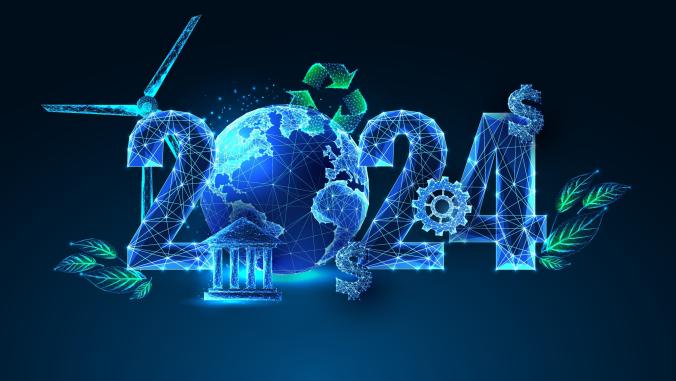Last in a four-part series. Read Part One, Part Two and Part Three.
An amazing thing is happening on our way through a pandemic. For a moment, imagine that you are not witnessing the dystopian partisan warfare between the president and the Congress. If you are able to divert your eyes from this daily exhibit of lost opportunities and incompetence, what would you see?
You would see a largely united nation. A flurry of recent public opinion polls reveals that the American people want not only a more effective response to the pandemic but, more fundamentally, they want more effective — and ambitious — government stewardship across a large suite of issues. In the words of Washington Post columnist Steven Pearlstein, "Americans have been remarkably responsive to competent leadership from others and remarkably willing to come together and sacrifice individual interests for the common good."
The pandemic has revealed America to itself — warts and all — and with it, a realization that the priorities and politics of the past 40 years do not shine a light for the way forward. Neither does it automatically open the door for ambitious proposals to advance sustainability.
Paradigms gathering moss
Major shifts in the agendas of democratic nations are generally slow to appear and disappear. For the American people to express their unity and sense of purpose in the midst of a pandemic reveals that something much bigger is going on. That something bigger is the process of letting go of two economic and political paradigms that have been followed during the past 40 years: fundamentalist market capitalism and the polarization of politics.
The pandemic has revealed America to itself — warts and all — and with it, a realization that the priorities and politics of the past 40 years do not shine a light for the way forward.
Market capitalism gone astray. For the past several generations, we have lived through an increasingly ideological application of the rules that govern market-based capitalism. Financial analysts have compressed the broad concept of value into a dominant metric of price paid at the time when a customer transaction occurs. When the idea of value changes from a social construct (in which all the factors of producing goods and services are included, including labor and R&D) to a more simplistic price point at the endpoint of a transaction, many bigger consequences follow. For the economic and social system, these have included:
- Emergence of shareholder value as the predominant objective of corporate management.
- Disproportionate growth of the financial sector as a portion of the overall economy.
- Reliance upon tax cuts to stimulate "trickle down" economic growth.
- Wage limits on labor contrasted with bonuses and share buybacks to incentivize upper management.
- Efforts to reduce regulatory costs (without estimating regulatory benefits).
- Outsourcing of production assets and supply chains to reduce directly measured labor and other input costs.
- Reduction of R&D budgets and expertise in favor of purchasing new knowledge and technologies through mergers and acquisitions.
- Focus on short-term financial performance over longer-term investments and returns.
Taken together, this package of ideas became the dominant playbook for academia, the corporate C-suite and government policymakers. While applied worldwide, this approach was especially influential in the United States. This redefinition of value, in the words of economics professor and author Mariana Mazzucato, made it easier for value-extracting activities [think hedge fund managers] to masquerade as value-creating entities.
While not explicitly abandoning market fundamentalism, larger financial houses such as BlackRock are recognizing the implications of these factors for post-pandemic economic planning. Analysts such as Scott Minerd of Guggenheim Investments estimates that it will take 10 years for unemployment to return to 2008 levels. He also foresees mounting political pressures to strengthen the social safety net through increased health care and job security and perhaps a guaranteed living wage.
In Minerd’s view, these proposals are feasible if policymakers design them to promote growth and reduce inequality. In the meantime, economic thought leaders such as Mazzucato, Kate Raworth, Steven Pearlstein, Rebecca Henderson and John Elkington continue to deconstruct market fundamentalism and create a broader definition of value in which sustainability plays a critical role. (The subject of a future column.)
Polarization of politics. The unity of the American people during the pandemic represents a rejection not only of Trump administration policies and values but a more fundamental repudiation of the politics of polarization enthusiastically practiced by both national political parties since the 1980s.
The polarization model worked best when each party made appeals to its political base, whose voters usually turned out on election day. Since neither side’s base commanded a majority of the electorate, two additional strategies were employed. The first was to appeal to independent, generally suburban voters. Donald Trump was elected in 2016 because a sufficient number of elderly, along with white suburban women, voted for him. The Democratic Party recaptured the House of Representatives in 2018 because enough white suburban voters defected from the Republican Party, and more African-American and Latino voters also voted Democratic.
The second strategy is to diminish the turn-out in the other side’s base. This effort has been a growing Republican objective and is credited with helping Trump win the critical states of Michigan, Pennsylvania and Wisconsin in 2016. Russian election interference that year aimed primarily at reducing the Democratic turnout.
The demography of the American electorate is undergoing an evolutionary, yet ultimately, a seismic transition. White males are becoming a decreasing percentage of eligible voters, while white women and minority groups (African-American, Asian-American and Latin American) keep expanding their percentage of the electorate.
Merging this changing voter profile, with the aftermath of a combined pandemic and depression, is creating a changed national policy agenda.
The emerging national agenda
For the foreseeable future (meaning one to two years past the 2020 election), the American people — and, therefore, national politics — will be principally focused on public health and job security issues. The trillions of dollars in new spending approved by the Congress and authorized by the Federal Reserve Board provide a short-term shoring-up of the economic and social safety nets, but trillions more are likely to be appropriated.
How can participants in the political process, including sustainability advocates, best navigate their way through the thicket of pandemic politics?
How can participants in the political process, including sustainability advocates, best navigate their way through the thicket of pandemic politics? Several guideposts include:
- The advantage currently belongs to those who support government action and know how to manage bureaucratic complexity for the public’s benefit. Most incumbent Republicans are generally opposed to this development but see a political necessity to keep enacting large spending bills. Many Democrats are polishing their updated spending proposals on a playing field that has shifted towards their agenda. Neither side will win a supermajority of 60 Senate seats in the November election, thus requiring modest coalition building to enact major legislation.
- Policy debates will pit the future vs. the past. There is increasing evidence that financial analysts will overlook publicly traded companies’ depressed 2020 earnings and refocus on 2021 performance. This provides a major opportunity for the private sector to pivot towards longer-term investments in innovation that also reduces financial risks by decoupling their reliance upon fossil fuels. Government policy has an opportunity to follow a similar path for its major investment.
By contrast, advocates of climate change proposals or the Green New Deal face limited prospects of legislative success in a Congress likely to remain dominated (in both parties) by industries that continue to shed jobs rather than create them. Many of these industries are rent-seeking rather than value-creating, contribute significantly to income inequality and remain tethered to a fossil fuel-based economy. - Link individual proposals to broader health care and job security legislative packages. In the U.S. political system, it is historically difficult to address more than one set of priorities at a time. Proponents for reducing inequality, mitigating climate change and other pollution, and investing in research and development should integrate their specific proposals within a health care and jobs framework. For example, reducing adverse health effects from air pollution can be directly coupled to funding legislation designed to reduce the risks from future pandemics. Proposals to invest in national transportation infrastructure can include sustainable infrastructure as a major decision criterion for the expenditure of funds.
Many ambitious proposals — a guaranteed living wage, the Green New Deal — are unlikely to pass through the ever-narrowing vortex of election-year politics. A future administration — Trump or Biden — will remain focused on health care and job security for the foreseeable future and is unlikely to satisfy the objectives of its most passionate left or right supporters. Sustainability proponents need to rethink the strategy for getting their most progressive proposals adopted.






